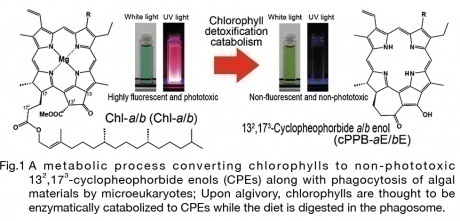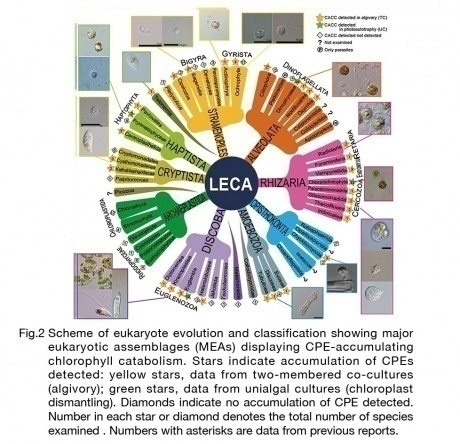- Home
- Faculty Members
- Department of Applied Chemistry and Food Science
- Yuichiro Kashiyama
Faculty of Environmental and Information Sciences
Department of Applied Chemistry and Food Science
- Key words
- Phototoxicity of chlorophylls, chlorophyll metabolisms, evolution of phototrophs, microalgae, protists, secondary plastids, early eukaryotes

Ph.D. (Science) / Professor
Yuichiro Kashiyama
Education
B.Sc. (1999): Department of Geology, University of Tokyo
M.S. (2001): Department of Geosciences, University of Rhode Island
Ph.D. (2007): Department of Earth and Planetary Science, University of Tokyo
Professional Background
2007-2010: JSPS Research fellow (Postdoctoral Fellow) at JAMSTEC/Univ. Tsukuba
2010-2012: R-GIRO Postdoctoral Fellow, Ritsumeikan Univ.
2013-2016: PRESTO Researcher, JST
2013- : Lecturer/Associate Professor/Professor, Fukui University of Technology
Consultations, Lectures, and Collaborative Research Themes
Lectures on the role of photosynthesis/phototrophy in ecosystems, mechanism of photosynthesis, aquatic microbiota, Earth's history, and evolutionary history of life
Main research themes and their characteristics
「Understanding risk management of the phototoxicity of chlorophylls in microbial cellular interactions」
Modern eukaryote ecology is primarily sustained by oxygenic photosynthesis, in which chlorophylls play essential roles. The exceptional photosensitivity of chlorophylls allows them to harvest solar energy for photosynthesis, but on the other hand, they also generate cytotoxic reactive oxygen species. The phototoxicity arises if their absorbed light energy is not rightly dissipated, where the redundant energy excites molecular oxygen. Thus, the management of the phototoxicity of chlorophylls must be a major concern within the cellular dynamics as well as in various biological interactions. For instanse, such risk must be critical particularly upon dynamic cellular interactions that potentially disrupt the mechanisms quenching photoexcited chlorophylls in the phototrophic cells.
Extensive examination of a wide variety of phagotrophic, parasitic, and phototrophic microeukaryotes demonstrates that a catabolic process that converts chlorophylls into non-photosensitive 132,173-cyclopheophorbide enols (CPEs) is phylogenetically ubiquitous among extant eukaryotes. CPE catabolism is identified in phagotrophic algivores belonging to virtually all major eukaryotic assemblages with the exception of Archaeplastida, in which no algivorous species have been reported. In addition, CPE catabolism is revealed to be common among phototrophic microeukaryotes (i.e., microalgae) along with dismantling of their secondary chloroplasts. Thus, it is implied that CPE catabolism primarily evolved among algivorous microeukaryotes to detoxify chlorophylls in an early stage of their evolution. Subsequently, it also underpinned photosynthetic endosymbiosis by securing close interactions with photosynthetic machinery containing abundant chlorophylls, which led to the acquisition of secondary chloroplasts. Series of my studies strongly suggest that CPE catabolism, which allowed the massive consumption of oxygenic primary producers, ultimately permitted the successful radiation of the eukaryotes throughout and after the late Proterozoic global oxygenation.
One of the main works of our laboratory focuses on elucidating the biochemical mechanisms of chlorophyll breakdown by algivorous protists and algae with the secondary plastids including the CPE-accumulating chlorophyll catabolism (CACC). Because CACC is universally distributed among all the Major Eukaryotic Assemblies, determination of a key gene responsible for CACC would promote understanding of evolutionary history of protistan algivory with CACC and further of ecology of the early eukaryotes.


Major academic publications
1.Y. Kashiyama, et al. (2019) Taming chlorophylls by early eukaryotes underpinned algal interactions and the diversification of the eukaryotes on the oxygenated Earth. ISMEJ 13: 1899–1910.
2.Y. Kashiyama & H. Tamiaki (2014) Risk management of organisms against the phototoxicity of chlorophylls. Chem. Lett. Highlight Review 43: 148–156.
3.Y. Kashiyama, et al. (2013) 132,173-Cyclopheophorbide b enol as a catabolite of chlorophyll b in phycophagy by protists. FEBS Lett. 587: 2578–2583.
4.Y. Kashiyama, et al. (2012) Ubiquity and quantitative significance of detoxification catabolism of chlorophyll associated with protistan herbivory. PNAS 109: 17328-17335.
5.Y. Kashiyama, et al. (2008) Evidence of global chlorophyll d. Science 321: 658-658.
